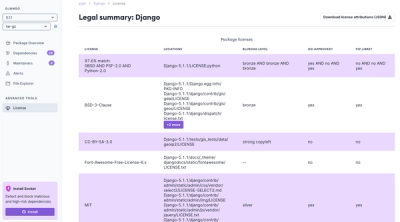
Product
Introducing License Enforcement in Socket
Ensure open-source compliance with Socket’s License Enforcement Beta. Set up your License Policy and secure your software!
leihs-ldap-authenticator
Advanced tools
LDAP based authentication handler for Leihs.

Provides LDAP authentication for Leihs 6.x.
When users want to log in, Leihs will redirect them to this authentication handler where they can authenticate themselves using an LDAP backend
Automatically create new users in Leihs when they first log in.
When logging in, users must be registered with Leihs. The LDAP authenticator takes care of this automatically when the user first logs in.
Register or log-in via email address or username.
Users can log in via username or email address. For technical details about how LDAP users are mapped, see LDAP Username Mapping below.
Automatic group assignment based on LDAP attributes.
When creating the users, they can be assigned to groups in Leihs based on their LDAP attributes. Groups will be automatically created if they do not yet exist.
Provides automatic configuration of the Leihs authentication system.
The authenticator will automatically register itself in Leihs.
Install the tool via pip:
❯ pip install leihs-ldap-authenticator
Download and edit the example configuration. The configuration keys are documented in the file:
❯ wget https://github.com/elan-ev/leihs-ldap-authenticator/blob/main/leihs-ldap.yml
Run the tool:
❯ python -m leihsldap -c /path/to/leihs-ldap.yml
The tool should automatically register itself in Leihs.
If you want to work with the development version instead, you can just clone this repository, install the requirements and run the project from the root repository path:
❯ pip install -r requirements.txt
❯ python -m leihsldap
* Serving Flask app 'leihsldap.web'
* Debug mode: off
* Running on http://127.0.0.1:5000
While you can just start and test the authenticator with the built-in web server, using this is not safe for production. For a production deployment, use a WSGI server like Gunicorn. A basic example of running this application with Gunicorn is:
❯ gunicorn --config=/path/to/gunicorn.conf.py leihsldap.web:app
For a systemd unit to turn leisldap into a service and for an example Gunicorn configuration file, take a look at the init folder:
If a user does not yet exist in Leihs, the system will always transfer the user input as an email address to the authenticator, regardless of it actually being a valid email address.
To circumvent this, the authenticator will treat the input up to the first @ character as username and use this for the LDAP login.
Once registered, Leihs will also transfer the login field which is used from there on for authentication.
As a general rule, the authenticator will only ever create, but never update data in Leihs. If you want updated data in Leihs, either update this manually, or remove the resource to have it recreated with new data.
This applies to:
This also means that you can update data if you need to. For example, you can add users to additional groups without the authentication system interfering (potentially removing them again).
This project is free software. It was initially developed by ELAN e.V. for Osnabrück University. We hope that this is helpful, and you can use this as well.
If you need commercial support installing this tool or want to commission further development you aren't able to do yourself, please contact the ELAN e.V.
To cut a new release:
main branch locally and create a release tag: git tag -s v0.4git push upstream v0.4:v0.4python setup.py sdist; twine upload dist/leihs-ldap-authenticator-0.2.tar.gzFAQs
Unknown package
We found that leihs-ldap-authenticator demonstrated a healthy version release cadence and project activity because the last version was released less than a year ago. It has 1 open source maintainer collaborating on the project.
Did you know?

Socket for GitHub automatically highlights issues in each pull request and monitors the health of all your open source dependencies. Discover the contents of your packages and block harmful activity before you install or update your dependencies.

Product
Ensure open-source compliance with Socket’s License Enforcement Beta. Set up your License Policy and secure your software!

Product
We're launching a new set of license analysis and compliance features for analyzing, managing, and complying with licenses across a range of supported languages and ecosystems.

Product
We're excited to introduce Socket Optimize, a powerful CLI command to secure open source dependencies with tested, optimized package overrides.